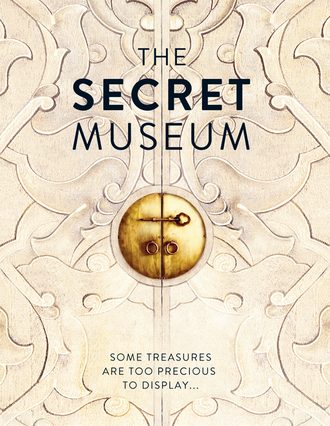
Полная версия
The Secret Museum
In his travels across the moon, a quarter of a million miles from Earth, Schmitt fell over or made contact with the moon more often than any other Apollo astronaut. His suit got very dirty as he crawled along collecting rocks, or from when he fell over and pushed himself upright again. Most of the Apollo spacesuits were dry-cleaned when they arrived back to Earth, but Schmitt’s never was. NASA wanted to preserve the final Apollo mission spacesuits just as they were. So dust from the lunar surface remains embedded in the fibre. I peered at the knees of his spacesuit. They were thick with grey lunar soil. I really got to look at the moon that day.
Apollo 17 was the flight when the astronauts were on the surface of the moon for the longest period of time, travelled furthest across it and collected the most lunar samples. This suit is just as it was when Schmitt, one of the last two men on the moon, left its surface, splashed back into the Pacific Ocean, took the spacesuit off and put his Earth clothes back on. It’s too precious to be displayed in the museum.
The people who have seen this spacesuit are the collections staff of the museum, scientists, researchers and the Apollo astronauts who come to see their suits, often with their grandchildren (Alan Bean, Apollo 12, is the astronaut who visits his suit most often), and NASA engineers. NASA’s design team is working on suits for Mars. The Mars suits will need to last longer and be able to be taken on and off more than the Apollo suits, but they’re a good place to start. Schmitt’s suit is especially useful in aiding with their design, as he tested it to the max, bounding about with rocks in his hand. They’ve looked inside using x-radiography and studied in detail the lunar soil that clings to it.
After marvelling at Schmitt’s suit, I looked around the room. On the bunk adjacent to it I saw a boot sticking out from beneath its sheet. It had a circular patch of Velcro on the sole. ‘What’s that?’ I asked the curators, pointing at the boot. ‘Oh, that’s Neil Armstrong,’ they said. This Velcro-soled boot was covered with an additional lunar boot when it stepped on to the moon but, still, it had covered the foot of Neil Armstrong when he took his ‘one giant step for mankind’.
Only Schmitt and Cernan’s lunar boots are back on Earth: they’re here in the museum collection as two of the most complete flown suits that made it back. The boots Neil wore inside the spaceship had Velcro on the soles so that he could stand still. The interior of the ship had Velcro laid down like a carpet so that, whenever the astronauts needed to be rooted in one place, they could stick themselves on to the ship. Presumably, they walked around making loud, ripping noises.
Neil Armstrong’s suit and under boots have been in storage for five years, having conservation work done on them. They won’t always be behind the scenes and the same goes for a lot of the suits. They’re here resting, between exhibitions, ‘in shavasana position’, as Lisa put it (that’s the yoga position where you lie on your back, meditating). It may be years before these suits are put on display, but it is possible to display them.
Schmitt’s will need to wait decades, at least, until it can come out of storage. Museums have not yet found a way to display it without damage to the suit and its precious moon dust.
Since I saw the suits, they have been on the move. They now live in their new storage facility, in Chantilly, Virginia. The new facility is part of the Air and Space museum’s sister museum, built near the airport, so that new air and space exhibits can be flown straight into the museum collection. The suits were moved in trucks, a few each day, snuggled into crates to keep them safe. The collections staff considered moving them in coffins but decided against it. In their new home, the suits are stored according to mission.
Now that I have seen the suits they wore, how fragile they are, considering they kept men alive on the moon, and now that I have seen lunar soil, on dusty knees 2 centimetres from my nose, the moon landings feel much more immediate. I wasn’t alive when mankind landed on the moon, so I missed the excitement that everyone who was must have felt listening to their radios, watching TV all over Earth and then gazing up at the white thing in the sky and imagining humans there in space. Now I know it wasn’t a hoax (unless of course the sheets we didn’t pull back actually covered Mickey Mouse suits …).
The moon landings also seem more surreal. The suits are made out of fibreglass fabric, a material that was first manufactured for household items. Cathy remembers that her ’parents had fibreglass curtains, the height of fashion in the sixties’. The suits seem far less robust than I had imagined. They have holes where the breathing apparatus was screwed on. They look so normal that they seem strange. They’re very low-tech, very human.
Seeing the suits has made me feel that something greater than NASA and Nixon must have been at work to get those men up there, keep them safe and bring them home. I’ve read that there was only a ten per cent chance the astronauts would make it back alive. Now, when I look at the moon and think of those fragile suits lying in shavasana, it feels to me as if the moon wanted to meet mankind. Maybe Mars will be next.

[Spacesuits] The spacesuits are dressed on mannequins and are laid out flat on their backs on metal bunk beds five to six bunks high.

[Planet Earth] ‘It suddenly struck me that that tiny pea, pretty and blue, was the Earth. I put up my thumb and shut one eye, and my thumb blotted out the planet Earth. I didn’t feel like a giant. I felt very, very small,’(Neil Armstrong)

[Schmitt on the moon] Schmitt checks out a lunar boulder on the moon. You can see the lunar rover to the right of the photo.
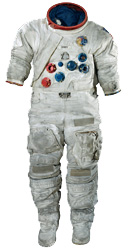
[Harrison Schmitt’s Spacesuit] Schmitt’s suit is too precious to put on display; it is covered in grey moon dust. I also saw Neil Armstrong’s suit, gloves and boots.

[Apollo 17 moon landing] Schmitt stands by the flag on the moon. You can see Earth in the black sky above.


BROTHER GUY CONSOLMAGNO IS THE curator of the Vatican Observatory. The observatory used to be in Rome, but moved out to the Pope’s summer home, Castel Gandolfo, in Albano, just outside Rome, when light pollution in the city made it impossible to see the stars.
I took a train from Rome to Albano. When I arrived, Brother Guy was waiting on the platform. I had thought he might be in monk’s robes, but he was wearing a red waterproof jacket, jeans and trainers. That is because he is a Jesuit and his order don’t wear robes, they prefer to blend in and work among lay people. He was immediately friendly, bright and charming and I knew it would be a fun day.
We walked up through the sleepy town until we reached the main square. It was quiet but for the sounds of birds and a few people chatting in restaurants. On one side of the square is a pink wall which divides the town from the papal grounds. Built into this wall is a door with a sign beside it carved into stone that reads ‘Specola Vaticana’. We opened the door and entered the Papal Grounds and the observatory’s museum. Guy explained that the Pope’s house is 2 kilometres away from the museum, across orchards and fields.
The observatory isn’t often open to the public. More often than not, the curators and astronomers have the place to themselves. However, the day I visited they were preparing for the arrival of 500 diplomats from around the world the following week and there were several people painting walls and polishing clocks in anticipation.
Guy showed me a film he was putting together for their visit. It tells the history of the observatory, one of the oldest astronomical institutions in the world. It was founded in 1582 when the Church replaced the Roman, or Julian, calendar with the Gregorian (which introduced the idea of having a leap year every four years to eliminate the discrepancies in time that had built up over the centuries). At first, the observatory’s telescopes pointed out at the universe from inside the Vatican itself, from a room called the Tower of the Winds.
The telescopes were brought to Albano in 1935. Guy has worked here for years. ‘It’s much better out here, the security isn’t so tight,’ he jokes. He spends half of his year here, researching, writing and teaching astronomy students. The other half of the year Guy spends in the desert, at the second Vatican Observatory in Tucson, Arizona. This is the home of the Vatican Advanced Technology Telescope, a very high-spec model with an internal mirror designed by a man called Roger Angel. ‘Yes, the Pope’s telescope was designed by an Angel,’ said Guy. ‘It is used for exploring new areas of the universe. I use it for looking at the colours of faint comet-like objects out beyond Neptune. These are the things that Pluto was part of before we realized that Pluto is not a planet but part of the vast band of Trans-Neptunian objects.’ He works there with a team of 14 others.
Back in Albano, Brother Guy works with another team to look after the observatory. He ushered me into the vast library of 20,000 books and journals. His favourite book is by a fellow Jesuit brother, Father Angelo Secchi (1818–78) and is called Sistema Solare, written in 1859. ‘It is the first book I’ve found that talks about the planets as real places you could walk around and have adventures on. Secchi takes facts and then uses his imagination to bring it all together. This book started planetary science. Before then, astronomers were far more interested in stars. Suddenly the planets became “places” rather than dots in the sky. They became things, not light.’
Guy showed me the Mars chapter of the book and pointed out where Secchi describes Mars as having canali (Italian for ‘channels’) on its surface. Some people thought, incorrectly, that Secchi was describing canals, like the ones on Earth, which did much to encourage the idea that there was life on Mars.
Outside the library is Brother Guy’s domain: the museum and its collection of space-related artefacts. There are different meteorites that flew around in space for around 15 million years until landing on our planet. Brother Guy explained that ‘10,000 pieces of rock fall to the Earth each year, but we humans collect about five of them, if we’re lucky. Most land in the ocean, or are lost because they look like ordinary rocks.’
There are also three pieces of Mars. Each piece of Mars rock is from a different part of the planet. How do we know they are from Mars? Firstly, because other meteorites contain metals and Mars rocks do not. Secondly, they are a billion years old, which is young, compared to the 4,568 billion-year ages of the other meteorites. And, thirdly, bubbles of gas trapped inside them have been tested using a mass spectrometer, and it turns out that they exactly match the atmosphere of Mars, as recorded by the Mars Rover.
The Vatican also has a globe of Mars, showing the channels on the planet, and a globe of the moon, the first ever made by NASA, given to the Vatican as a gift.
I asked Brother Guy if he had a favourite treasure in the collection. He said that it changed all the time; he loves the Mars rocks, but his favourite meteorite that day was Allende. There are two tons of it in the world and it revolutionized science. ‘It fell in 1969, just before the moon landing. NASA had been buying all sorts of toys with which to measure moon rocks, which they hoped the astronauts would bring back to Earth. So they were able to test their toys on Allende. They discovered that the little white bits inside the meteorite were dust from stars that existed even before the planets were formed. This changed the way NASA thought about the solar system; they had known it was about 4.6 billion years old but, thanks to Allende, they could measure the age more precisely, to 4.568 billion’.
Brother Guy got even more cosmic. ‘It’s strange to think that we humans – who are all made of stardust – look up at the sky to study galaxies, without often reflecting on the fact that what we’re actually studying is light. The things we’re looking at are no longer really there.’ That is one reason why he likes working in the meteorite lab, among the ‘real stuff’, which he can pick up and measure.
We decided to visit his lab, but to have a drink first. Over a delicious coffee, which Brother Guy served in ‘Specola Vaticana’ cups, he told me how he had ended up as curator of meteorites at the Vatican. He grew up in Detroit. He loved space and saved up 16 books of stamps to swap for his first telescope. He joined the Jesuit order and it was they who decided that this was the job for him. He says he would have been just as happy serving soup, if that is what the Jesuits had decided, but he is surely the perfect man for the job here at the Vatican.
Inside his lab, one surface is covered with microscopes and one weird instrument that looks like a saucepan, used to suck water off meteorites. The rest of the room is full of cupboards filled with drawers containing slices of meteorite. Propped up on a cupboard is a painting of the planets, each one studded with jewels. No one really knows who made it or how it ended up in in the lab, but it’s beautiful.
Brother Guy popped a 4.6-billion-year old meteorite into my hand. This was the oldest in the collection and was found in France in 1810. Lots of locals saw it fall from the sky and then had to convince sceptical scientists that it was space rock. It has a handwritten label attached to it telling how it fell to earth in L’Aigle.
On the wall is a photograph of the current Pope looking into a microscope at a section of meteorite. Brother Guy showed him two; one found near his hometown in southern Germany; the other one in the Ukraine in 1866. Brother Guy showed me the second slice. He took it out of its drawer and slid it under a microscope that shone polarized light. ‘It’s like looking through a kaleidoscope,’ I said. Brother Guy turned the slide in circles, and bright colours shifted into new patterns. It was bizarre that so many shapes could appear from something that looked so bland and tiny on the slide. ‘All the meteorites do this under polarized light,’ Brother Guy added, ‘but this is the prettiest of them all.’
Brother Guy made a Christmas card out of an image of the meteorite I was looking at, because he thinks a pattern within it looks like Jesus in a manger. He gave me one of the cards. On the back, it says, ‘The meteorite samples formed in the proto-solar nebula around our sun, 4.56 billion years ago.’
This card is not your average Christmas card, and not one you’d expect to get from the Vatican, at least, not unless you know about Brother Guy and the two Vatican observatories.

[Mars canals] Secchi drew some of the first colour illustrations of Mars and referred to the canali, the Italian word for channels, on the surface of the planet. Some nineteenth-century and early twentieth-century astronomers thought ‘canali’ meant ‘canals’ and used them as evidence that there was life on Mars.
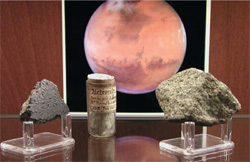
[Three pieces of Mars] The Vatican Observatory owns three pieces of Mars rock, each one from a different part of the planet.
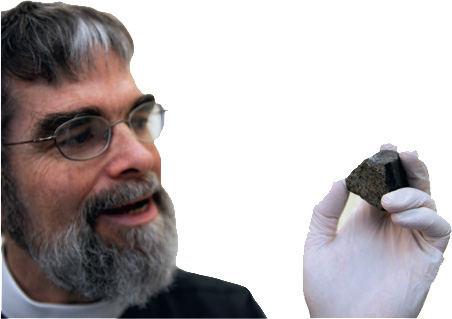
[Brother Guy J. Consolmagno] Brother Guy was assigned the job of astronomer at the Vatican Observatory when he became a Jesuit. He showed me around the Vatican meteorite collection at the Pope’s summer residence.

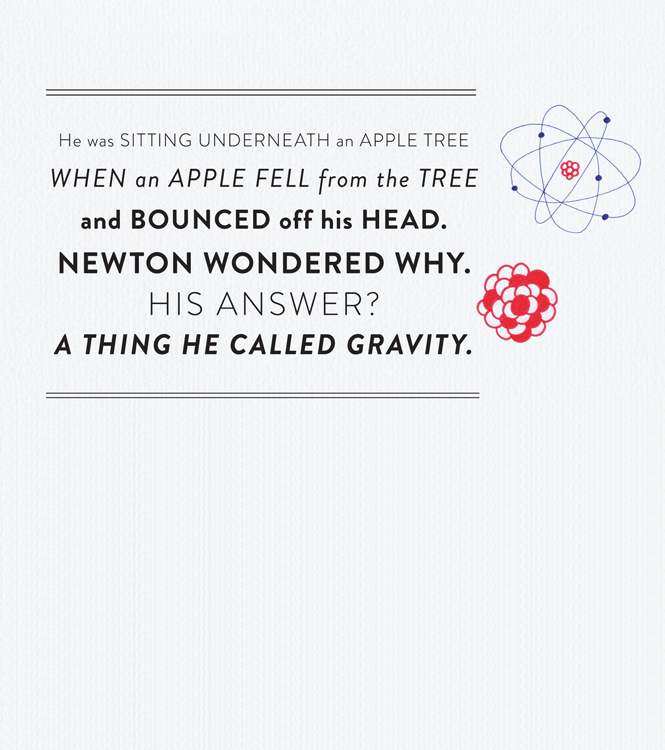
THE ROYAL SOCIETY IN LONDON began in 1660, when a group of scientists decided it would be valuable to meet once a week and discuss experiments. Today it is one of the oldest scientific academies in the world.
Their archive is split between a salt mine in Cheshire – to access anything down there you have to go in a miner’s lift and put on a hard hat and a basement in its HQ in London.
I headed downstairs into the basement, which is stuffed with a quarter of a million manuscripts made up of the musings, publications and letters written by some of the greatest scientific minds that have ever lived.
Mixed in among the books and writings are 200 objects, including slides of a goat with the bends (used when working out dive tables), a wonderful doodle on blotting paper by top scientists and the then prime minister gathered at a meeting about the Transit of Venus in 1882, tag and a wooden potato masher made by a young Ernest Rutherford for ten his grandma. I looked a bit confused. ‘Rutherford,’ said Keith Moore, curator of the Royal Society’s library and archives, ‘split the atom.’ Rutherford is buried in Westminster Abbey, near Sir Isaac Newton.
Pretty much everyone has heard the story about how Newton first described gravity. He was sitting underneath an apple tree when an apple fell from the tree and bounced off his head. Newton wondered why. His answer? A thing he called gravity. Anyone who has looked deeper into the tale comes up against people saying it wasn’t true.
But Newton knew the value of a good anecdote and told it himself. In the Royal Society library there is a first-hand account of him describing the event to William Stukeley, author of Memoirs of Newton’s Life (1752):
After dinner, the weather being warm, we went into the garden and drank thea [sic], under the shade of some apple trees; only he, and myself. Amidst other discourse, he told me, he was just in the same situation, as when formerly, the notion of gravitation came into his mind. Why should that apple always descend perpendicularly to the ground, thought he to himself; occasion’d by the fall of an apple, as he sat in a contemplative mood. Why should it not go sideways, or upwards? but constantly to the earths centre?
So the apple tree really did inspire Newton, even if the apple didn’t fall on his head. The account is online on the Royal Society’s website if you want to see it.
Just as Newton had never before considered why it was that apples fall to the ground, even though I had heard the story many times before I’d never wondered which actual apple tree had inspired him. That was, until I saw several pieces of it behind the scenes at the Royal Society.
Newton’s fabled apple tree once stood in the garden of his childhood home, Woolsthorpe Manor in Lincolnshire. In 1800, the inspirational tree blew over. Luckily, it re-rooted itself, and a new tree, an offshoot from the original, is still flourishing there today.
The owner of Woolsthorpe Manor saved some pieces of Newton’s original apple tree after it blew over. Some of them are in the Royal Society archives. On a shelf down in the cool basement are two fragments, as well as two rulers and a prism made from the wood. One of the fragments is in a little pink plastic bag, because it has just been on an adventure, up into orbit aboard the Space Shuttle Atlantis in 2010. It will remain in the pink bag, because the bag is now part of its history.
The apple wood was taken up into orbit so that it could experience zero gravity. The plan was also to drop a real apple on the space station and film whether it was subject to gravity or not. They weren’t able to do the test because an astronaut who didn’t know what they were up to – she will remain nameless – saw the apple lying around and ate it. They could hardly pop out to the shops, so they had to make do with a pear. You can watch a film of it floating.
Keith told me the pear is flying, not because it wasn’t subject to gravity, but because the space station is falling, and the pear with it, in orbit. ‘Just look at the astronauts’ hair,’ he said. It floats above their heads.
Also in the archives is a lock of Newton’s hair – perhaps with high concentrations of mercury in it, as a result of his alchemical experiments – and his death mask. ‘This is the closest you’ll get to Isaac Newton,’ said Keith.
We looked at a drawing of Newton’s apple tree, sketched by Thomas Howison in the 1820s. It is of the original tree, which lies dead on the ground, and the re-rooted tree beside it. Keith had just been having a good look at it and discovered a new secret. We peered at it (have a look yourself) and could just make out the outline of Newton sitting underneath the tree. Keith had seen the picture countless times but had only just noticed the faintly drawn figure beneath it. ‘The archives are still turning up secrets,’ he said.
On a shelf beside the pieces of apple tree sits Newton’s reflecting telescope (he donated it to the Royal Society; they lost it for a while but it turned up again in the 1730s in an instrument maker’s workshop). It has two mirrors inside, and two tubes, which you slide to focus the mirrors.
Before Newton had the brainwave of using mirrors, looking at the stars meant holding two enormous and unwieldy lenses far apart, tied together by pieces of string. Newton mounted his old, big telescope on a maypole, which he’d bought on Charing Cross Road.
He invented this small, wood and leather reflecting telescope while he lived in Cambridge. Later, he came to London and worked from a laboratory at the Tower of London, where he was Master of the Royal Mint. Imagine him peering up into space from his rooms inside the Tower.
When he made his telescope he sent his idea to the Royal Society and included a drawing. I loved looking at Newton’s sketch, complete with an eye looking down into the telescope. Then I was able to put my own eye to his telescope, just as he would have done. All I could see was the wall of the basement, but I got the idea. Amazingly, centuries later, the Hubble space telescope was built using essentially the same design.
The Royal Society owns many of the letters Newton sent over the years, explaining what he was up to. Some were expanded upon and turned into publications. The original manuscripts of these texts are here in the archive.
We looked at the original copy of the Principia (Philosophiae Naturalis Principia Mathematica) that Newton sent away to be published. This first copy was written up by his secretary and has marginalia in Newton’s hand and in the writing of his friend Edmund Halley – of Halley’s Comet fame who paid for it to be published.
The Royal Society was planning to cover the costs, but the publication of A History of Fishes, by Francis Willughby and John Ray, had left them out of pocket. Samuel Pepys was the Society’s president at the time and is named on the title pages of both the Principia and A History of Fishes (his diary wasn’t published until 123 years after he died).


